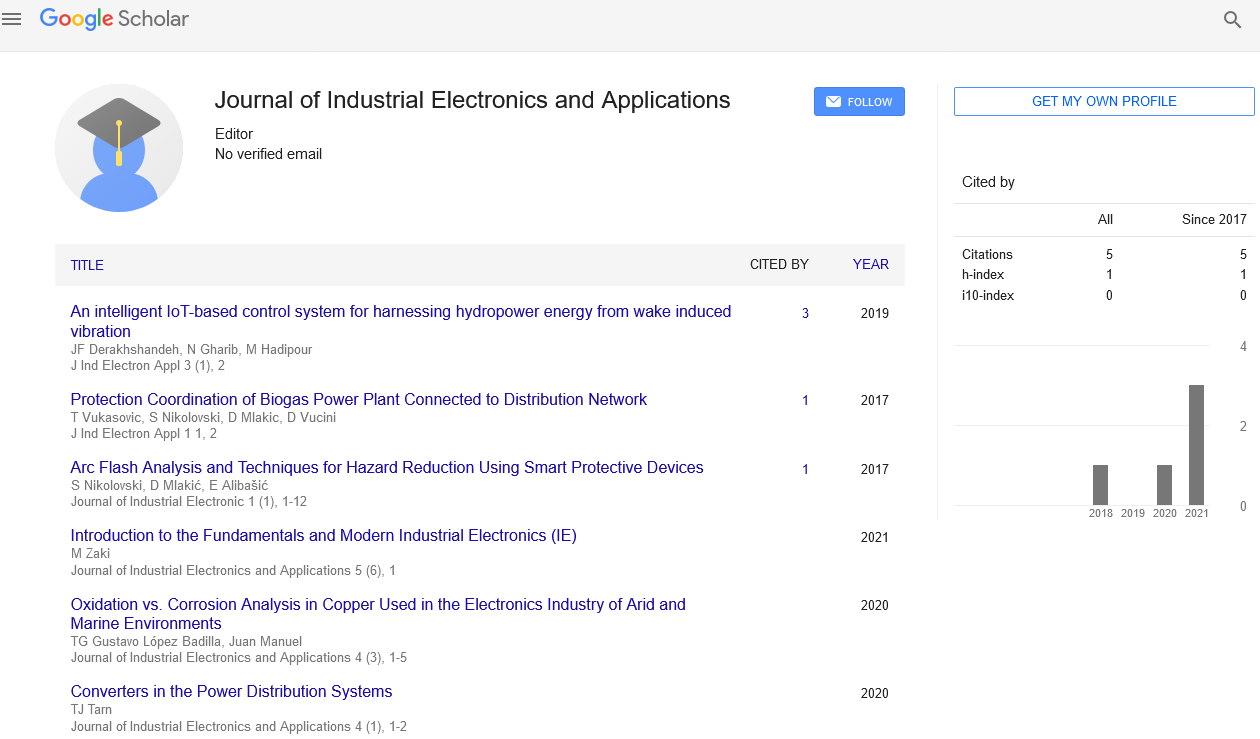Commentary, J Ind Electron Appl Vol: 7 Issue: 2
Self-Powered Sensors: Energizing the Future of Sustainable Sensing
Eynard Speranza*
1Department of Mechanical Systems Engineering, Université de Technologie de Compiègne, Cedex, France
*Corresponding Author: Eynard Speranza,
Department of Mechanical Systems
Engineering, Université de Technologie de Compiègne, Cedex, France
E-mail: speranza.e22@hotmail.com
Received date: 29 May, 2023, Manuscript No. JIEA-23-107955;
Editor assigned date: 31 May, 2023, PreQC No. JIEA-23-107955 (PQ);
Reviewed date: 15 June, 2023, QC No. JIEA-23-107955;
Revised date: 22 June, 2023, Manuscript No. JIEA-23-107955 (R);
Published date: 29 June, 2023, DOI: 10.4172/JIEA.1000033.
Citation: Speranza E (2023) Self-Powered Sensors: Energizing the Future of Sustainable Sensing. J Ind Electron Appl 7:2.
Abstract
Description
In the rapidly advancing landscape of sensor technology, the quest for sustainability and energy efficiency has become paramount. Selfpowered sensors have emerged as a transformative solution to address the growing demand for autonomous, eco-friendly sensor systems. By harnessing energy from their environment or employing innovative energy-harvesting techniques, these sensors can operate without relying on external power sources. In this commentary article, we delve into the significance of self-powered sensors, their potential applications, and the impact they could have on various industries and everyday life.
The rise of self-powered sensors
Conventional sensors typically rely on batteries or wired power sources, leading to concerns about energy consumption, environmental impact, and maintenance costs. Self-powered sensors aim to overcome these limitations by leveraging energy from ambient sources, such as light, vibrations, temperature gradients, and even radiofrequency signals. The development of efficient energy-harvesting technologies and ultra-low-power electronics has paved the way for self-sustaining sensing devices that operate indefinitely without the need for battery replacements.
Harnessing energy from the environment
One of the most promising aspects of self-powered sensors is their ability to extract energy from their surroundings. For instance, photovoltaic cells integrated into the sensor's design can harvest solar energy, converting it into electricity to power the sensor. Similarly, piezoelectric materials can generate electrical energy from mechanical vibrations, making self-powered sensors suitable for applications in rotating machinery monitoring and structural health monitoring.
Thermoelectric materials offer another avenue for energy harvesting, as they convert temperature gradients into electricity. This capability enables self-powered sensors in environmental monitoring and energy-efficient building management. Moreover, radiofrequency energy harvesting allows sensors to capture and convert ambient wireless signals into electrical power, enabling wireless sensor networks that operate perpetually.
Advancing energy-harvesting technologies:
Researchers are continually exploring innovative energy-harvesting techniques to enhance the efficiency and versatility of self-powered sensors. This includes developing nano generators and triboelectric devices that convert mechanical motion into electrical energy with high sensitivity and reliability. Furthermore, the integration of flexible and stretchable energy harvesters unlocks new possibilities for wearable self-powered sensors that conform to the human body.
Additionally, advancements in piezoelectric and thermoelectric materials research hold promise for improving energy conversion efficiency, enabling self-powered sensors to harvest even small amounts of ambient energy effectively. Nanoscale energy-harvesting technologies also present exciting prospects for self-powered sensors in Nano-Electromechanical Systems (NEMS) and Internet of Nano- Things (IoNT) applications.
Applications in various industries
Self-powered sensors offer transformative benefits across numerous industries
Healthcare: In remote and resource-limited areas, self-powered medical sensors can play a critical role in patient monitoring and health management without the need for frequent battery replacements.
Environmental monitoring: Self-powered sensors are valuable tools for continuous environmental monitoring, providing real-time data on air quality, water quality, and weather conditions.
Structural health monitoring: In infrastructure and civil engineering, self-powered sensors can be embedded in buildings and bridges to monitor structural integrity and detect early signs of damage.
Internet of things (iot): Self-powered sensors are vital components of IoT networks, contributing to the proliferation of smart and sustainable connected devices.
Wearable electronics: Self-powered sensors integrated into wearable devices enable continuous monitoring and personalized health tracking without interrupting user experiences.
Industrial automation: In industrial settings, self-powered sensors can be deployed in remote or hazardous locations, reducing maintenance costs and enhancing efficiency.
Overcoming challenges:
While self-powered sensors offer remarkable advantages, some challenges need to be addressed for widespread adoption:
Energy efficiency: Continuous advancements in energy-harvesting technologies are essential to improve the efficiency of energy conversion and ensure optimal sensor performance.
Power management: Implementing sophisticated power management algorithms is crucial to efficiently utilize harvested energy and extend the operational lifetime of self-powered sensors.
Environmental variability: Different energy-harvesting methods have varying performance in different environments, requiring sensor designs that can adapt to specific application scenarios.
Miniaturization: Developing small and compact self-powered sensors is vital for integration into compact devices and wearable electronics.
The path forward: A sustainable sensing future
The future of self-powered sensors appears promising, driven by ongoing research and development efforts. As energy-harvesting technologies evolve, we can expect self-powered sensors to become more prevalent in a wide range of applications, transforming how we perceive and interact with our environment. Their autonomy and sustainability will reduce the environmental footprint of sensor networks, fostering a more sustainable and eco-conscious approach to sensing technologies.
Researchers, industry experts, and policymakers must collaborate to accelerate the adoption of self-powered sensors. Supporting research initiatives, creating favorable regulatory environments, and promoting interdisciplinary partnerships will be crucial in realizing the full potential of self-powered sensors.
Conclusion
Self-powered sensors represent a groundbreaking advancement in sensor technology, enabling autonomous and sustainable sensing solutions. By harnessing energy from their environment or employing innovative energy-harvesting techniques, these sensors eliminate the need for external power sources and reduce maintenance efforts. Their potential applications across various industries, including healthcare, environmental monitoring, and IoT, have the potential to revolutionize how we interact with our surroundings. The continued advancements in energy-harvesting technologies and materials research will drive the growth of self-powered sensors, making them increasingly efficient, versatile, and adaptable. As these sensors become more integrated into our daily lives and industrial processes, we move one step closer to a sustainable sensing future, where sensor networks operate perpetually and responsibly, contributing to a greener and smarter world.
 Spanish
Spanish  Chinese
Chinese  Russian
Russian  German
German  French
French  Japanese
Japanese  Portuguese
Portuguese  Hindi
Hindi 